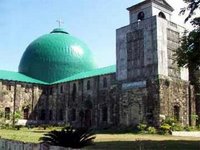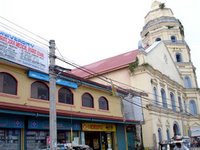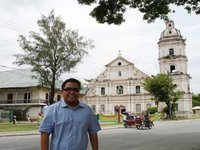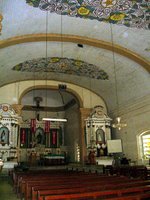 Pangasinan has a lot of heritage churches. And it being a really big province, the churches are scattered all over. One route is the Western Pangasinan route from Camiling, Tarlac to Bolinao, Pangasinan. I noticed old churches in the towns of Mangatarem, Aguilar, Bugallon, Lingayen, Labrador, Alaminos, and Bolinao.
Pangasinan has a lot of heritage churches. And it being a really big province, the churches are scattered all over. One route is the Western Pangasinan route from Camiling, Tarlac to Bolinao, Pangasinan. I noticed old churches in the towns of Mangatarem, Aguilar, Bugallon, Lingayen, Labrador, Alaminos, and Bolinao.The first stop is the church in Mangatarem. You can't miss the Mangatarem Church because of its large green dome. The convento beside it is also intact but renovations have been done to the interior.
 Aguilar is a next town. The Aguilar Church is very much intacts since the simple ceiling paintings, its wooden retablo and the convento are still there. I hope it stays that way.
Aguilar is a next town. The Aguilar Church is very much intacts since the simple ceiling paintings, its wooden retablo and the convento are still there. I hope it stays that way. Bugallon does not seem to have an old church. That's because the old town church is not along the National Highway. You'll have to enter Brgy. Salasa to see this old red brick church. The Salasa Church even has remnants of its old perimeter wall still standing.
Bugallon does not seem to have an old church. That's because the old town church is not along the National Highway. You'll have to enter Brgy. Salasa to see this old red brick church. The Salasa Church even has remnants of its old perimeter wall still standing. Since I started late in the afternoon, I stayed in Lingayen for the night. It's a coastal town and if you're very observant, you'll notice some colorful birds every now and then. The Lingayen Co-Cathedral (its co-cathedral is in Dagupan). This one is a depressing story. And it is a blatant example of Roman Catholic Church, Inc. which I mentioned in the visita iglesia in Batangas post.
Since I started late in the afternoon, I stayed in Lingayen for the night. It's a coastal town and if you're very observant, you'll notice some colorful birds every now and then. The Lingayen Co-Cathedral (its co-cathedral is in Dagupan). This one is a depressing story. And it is a blatant example of Roman Catholic Church, Inc. which I mentioned in the visita iglesia in Batangas post.The centuries-old convento was demolished and a commercial structure was built to replace it, all under the watch of Archbishop Oscar Cruz. I expected much more from Archbishop Cruz. This incident is very sad.
 When in Lingayen, make sure to drop by the Pangasinan Capitol and Lingayen Beach which is famous because of the MacArthur Landings during the Second World War. Several years back, even the Spanish colonial Casa Real was still intact. But a typhoon blew off its roof and it's now in a very sad situation.
When in Lingayen, make sure to drop by the Pangasinan Capitol and Lingayen Beach which is famous because of the MacArthur Landings during the Second World War. Several years back, even the Spanish colonial Casa Real was still intact. But a typhoon blew off its roof and it's now in a very sad situation. On the way to Alaminos, you'll pass by the town of Labrador. I noticed the church was a bit old but I wasn't able to stop to investigate it further. Alaminos Cathedral, just like many cathedrals, has been renovated inside. It's sad because many of the old houses are still intact. I wonder when they demolished the orginal municipio because the plaza would have made an interesting cultural tourism attraction.
On the way to Alaminos, you'll pass by the town of Labrador. I noticed the church was a bit old but I wasn't able to stop to investigate it further. Alaminos Cathedral, just like many cathedrals, has been renovated inside. It's sad because many of the old houses are still intact. I wonder when they demolished the orginal municipio because the plaza would have made an interesting cultural tourism attraction.I hope Mayor Hernani Braganza realizes the strong potential of Alaminos, not just as an eco-tourism destination, but as a cultural and culinary destination. I'd really enjoy it if some of those old houses were converted into restaurants that serve Alaminos longaniza among other things! It would be a great stopover when visiting the Hundred Islands or Bolinao.
 At the end of the road is Bolinao Church. I'll talk more about Bolinao in a different post. But worth mentioning is that it is challenging the claim of Limasawa as the site of the first Mass in the Philippines. Records say that it was Italian missionary Blessed Odorico who, on his way to china, said the first Mass when he took refuge in Bolinao Bay during a storm in 1324. The claim further mentions that he even baptized several locals making him the first evangelizer in the Philippines.
At the end of the road is Bolinao Church. I'll talk more about Bolinao in a different post. But worth mentioning is that it is challenging the claim of Limasawa as the site of the first Mass in the Philippines. Records say that it was Italian missionary Blessed Odorico who, on his way to china, said the first Mass when he took refuge in Bolinao Bay during a storm in 1324. The claim further mentions that he even baptized several locals making him the first evangelizer in the Philippines.You can also do the Central Pangasinan route which takes you to Manaoag, Calasiao, San Carlos and Binmaley among others.
Part 2: Hundred Islands in Alaminos, Pangasinan
Part 3: Tondol White Sand Beach in Anda, Pangasinan during high tide








